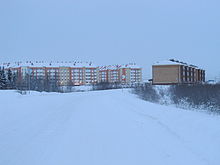This article needs additional citations for verification. (October 2022) |
Polar night is a phenomenon that occurs in the northernmost and southernmost regions of Earth when the Sun remains below the horizon for more than 24 hours. This only occurs inside the polar circles.[1] The opposite phenomenon, polar day or midnight sun, occurs when the Sun remains above the horizon for more than 24 hours.
There are multiple ways to define twilight, the gradual transition to and from night when the Sun is below the horizon. "Civil" twilight occurs when the Sun is between 0 and 6 degrees below the horizon. Nearby planets like Venus and bright stars like Sirius are visible during this period. "Nautical" twilight continues until the Sun is 12 degrees below the horizon. During nautical twilight, the horizon is still visible enough for navigation. "Astronomical" twilight continues until the Sun has sunk 18 degrees below the horizon. Beyond 18 degrees, refracted sunlight is no longer visible. The period when the sun is 18 or more degrees below either horizon is called astronomical or true night.
Since the atmosphere refracts sunlight, polar day is longer than polar night, and the area that is affected by polar night is somewhat smaller than the area of midnight sun. The polar circles are located at latitudes between these two areas, at approximately 66.5°. While it is day in the Arctic Circle, it is night in the Antarctic Circle, and vice versa.
Any planet or moon with a sufficient axial tilt that rotates with respect to its star significantly more frequently than it orbits the star (and with no tidal locking between the two) will experience the same phenomenon (a nighttime lasting more than one rotation period).
- ^ Burn, Chris. The Polar Night (PDF). The Aurora Research Institute. Retrieved 28 September 2015.


